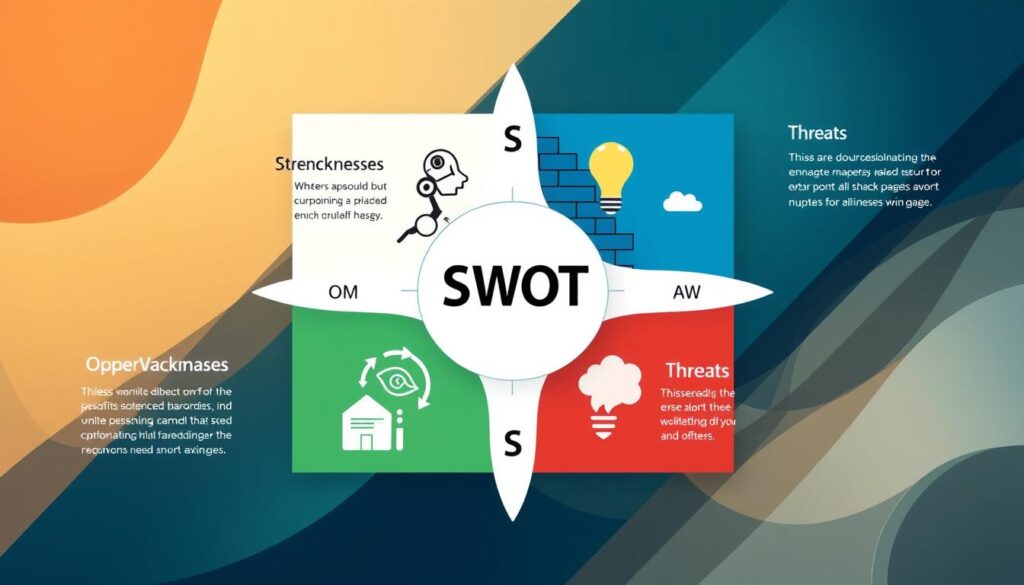Ever wondered why some small businesses do well while others struggle? It often comes down to how well they know their strengths and weaknesses. They also look at what opportunities and threats are out there. This complete guide on SWOT analysis for small businesses will help you improve your business strategy.
Knowing what SWOT stands for—Strengths, Weaknesses, Opportunities, and Threats—is vital. This guide will teach you how to do a SWOT analysis for small businesses. You’ll learn how to make smart choices that help your business grow and stay strong.
Table of Contents
Key Takeaways
- SWOT analysis provides a structured method for identifying key business factors.
- Understanding strengths and weaknesses allows for targeted improvements.
- Opportunities can be leveraged to expand and optimise your business model.
- Identifying threats prepares you to counteract possible market disruptions.
- Regularly revisiting your SWOT analysis keeps your strategy aligned with current market conditions.
- Utilising digital tools can streamline your SWOT analysis process.
- Effective teamwork is essential for a thorough SWOT analysis.
Understanding SWOT Analysis
A SWOT analysis is a detailed way to look at a business’s place in the market. It breaks down a company’s strengths, weaknesses, opportunities, and threats. Knowing what a SWOT analysis is helps you spot key factors that affect your business.
Definition of SWOT Analysis
The SWOT analysis is a key tool for planning. It looks at what’s strong inside the company, like a great team or service, and what’s weak, like not enough marketing or too much debt. It also considers outside chances, like new tech, and dangers, like new rivals or changing rules.
Importance of SWOT Analysis in Business
SWOT analysis is very important for businesses. It helps you see how different things affect your decisions. Doing a SWOT analysis gives you the knowledge to make a strong business plan. It helps you find ways to stay ahead and make smart choices.
This tool also helps you understand challenges better. It lets you see things from different angles. This way, you can get a clearer view of the market.
SWOT Analysis for Small Businesses
For small businesses, knowing your strengths and weaknesses is key to success. A SWOT analysis helps you see what you’re good at and what you need to work on. It also shows you the opportunities and threats you face. This gives you a clear view of your business’s place in the market.
The Relevance to Small Enterprises
Using a SWOT analysis can really help small businesses make better choices. It helps you understand what makes you stand out and what might hold you back. By knowing these things, you can build a stronger business that can compete well.
Key Considerations for Small Business Owners
Small businesses need to think about both inside and outside factors. Looking at market trends and what competitors are doing is important. It helps you find chances to grow and stay ahead of the game.
| SWOT Element | Key Questions |
|---|---|
| Strengths | What internal resources or advantages does your business possess? |
| Weaknesses | What areas are lacking or need improvement within your operation? |
| Opportunities | What external trends or changes can your business leverage for growth? |
| Threats | What external challenges or obstacles threaten your business success? |
Doing a SWOT analysis can really help small businesses. For more on using data to make better choices, check out this guide.
Components of SWOT Analysis
SWOT analysis looks at four key areas to help businesses understand their market position. It highlights internal and external factors that affect strategy and growth.
Strengths: Internal Factors You Control
Strengths are the internal factors that give your business an edge. They include unique skills, resources, or processes. Knowing your strengths helps you see what’s working well.
For example, reaching high revenue or achieving customer service goals is important. It shows your business is doing well, if you market it right.
Weaknesses: Areas for Improvement
Weaknesses are areas where your business can get better. They might be skills gaps, resource shortages, or inefficient processes. By spotting these, you can improve your business.
Doing a thorough SWOT analysis helps highlight weaknesses. This makes it easier to focus on improving.
Opportunities: External Factors for Growth
Opportunities are external factors that can help your business grow. They include market trends, legal changes, or new technologies. Staying alert to these can help you adapt and grow.
Understanding the outside world is key to setting future goals. It helps you make the most of new chances.
Threats: Challenges in the External Environment
Threats are external challenges that could slow your business down. They include competition, economic downturns, or changes in what customers want. It’s important to spot these threats early.
This way, you can plan how to deal with them. For example, restaurants that did SWOT analyses during the pandemic found ways to adapt. They moved to takeout and delivery to keep customers coming.
| SWOT Component | Nature | Examples |
|---|---|---|
| Strengths | Internal | Unique skills, loyal customer base, strong revenue streams |
| Weaknesses | Internal | Lack of skilled personnel, limited resources, outdated technology |
| Opportunities | External | Market trends, legislative support, new technology |
| Threats | External | Increased competition, economic downturns, changing consumer preferences |
The SWOT Analysis Process
The SWOT analysis process has several key steps. It helps you understand your business’s strengths, weaknesses, opportunities, and threats. Each step is important for getting team input and planning for the future. It’s also good to have different team members’ views.
Gathering Input from Your Team
To start, you need to get input from your team. It’s important to include everyone. This way, you get many different ideas. Ask your team about your business’s strengths, weaknesses, growth chances, and threats.
Conducting the Analysis
After you’ve gathered input, it’s time to do the analysis. Use tools like grids to make it clearer. This helps you sort out the insights into strengths, weaknesses, opportunities, and threats. Look for patterns to help with planning.
Documenting the Results
Lastly, you need to document your findings. Make sure to write it down clearly. This document will help you plan for the future. It makes it easy to check and improve your strategies over time.
SWOT Analysis Template
Using a SWOT analysis template makes evaluating easier. It gives a clear structure for listing important information. This way, you can list strengths, weaknesses, opportunities, and threats well. It helps in making better decisions.
Clear templates help turn brainstorming into focused discussions. Teams can then work together to find strategic insights.
How to Use a SWOT Analysis Template
Start by filling out the template with your team’s insights. Look at both internal and external factors. Here’s how:
- Get team insights on the business environment.
- Start with strengths and weaknesses to focus on what’s inside.
- Look at external opportunities and threats by studying market trends and competitors.
- Discuss the filled-out template together to plan strategically.
Examples of Effective Templates
Many resources offer good templates for different industries. For example:
| Resource | Template Type |
|---|---|
| Bplans | Downloadable SWOT analysis template for online stores and food businesses |
| BusinessBalls | Free SWOT tools in Word and PDF formats |
| MindTools | SWOT worksheet with questions for deep analysis |
| Priority Matrix | Free SWOT template with a seven-step analysis |
| SlideModel | Free PowerPoint SWOT templates for presenting findings |
| Smartdraw | SWOT analysis diagrams for quick understanding |
| Superside | More than 20 unique PowerPoint templates for detailed SWOT analysis |
Choosing the right SWOT analysis template keeps your evaluation organised. It also brings out key insights for better business strategies. Regularly update your analysis for ongoing improvement. For tips on business names to match your SWOT analysis, check out this resource.
Benefits of Conducting a SWOT Analysis
Using a SWOT analysis can greatly benefit your business. It helps in making better plans and decisions. You can spot key chances and risks in the market and use your resources wisely.
The insights from a SWOT analysis help create strong strategies. These strategies match your business goals.
Strategic Planning and Decision Making
A SWOT analysis helps in planning your business strategy. It helps you decide on new products or expanding into new markets. Regular checks, like every quarter, help you understand your business better.
Studying industry trends is key to improving your plans. It keeps you ready for any changes.
Enhancing Team Collaboration
A SWOT analysis gets your team involved. This makes them feel more connected to your goals. It creates a space for open talks and new ideas.
It helps your team understand the company’s direction better. They can also contribute more to your strategy.
| Benefits | Description |
|---|---|
| Opportunity Identification | Discover market opportunities that may have been previously overlooked. |
| Resource Optimisation | Identify areas to enhance resource efficiency. |
| Risk Management | Spot possible threats that could harm your business. |
| Innovation | Find areas for improvement or new trends. |
| Enhanced Team Commitment | Make your team feel more involved. |
To get the most from your SWOT analysis, keep detailed records. Use these in your strategic plan. This way, you stay aware of your strengths and keep looking for ways to improve.
For more help with planning, check out the Small Business Administration. They offer tools and resources to help you use a SWOT analysis effectively.
SWOT Analysis Examples
Looking at SWOT analysis examples can really help you understand how small businesses use this tool. Case studies show how companies use their strengths to grab opportunities. They also show how to deal with weaknesses and threats. These examples can help you improve your strategy.
Case Studies of Successful Small Businesses
Many examples show how well SWOT analysis works in different fields:
- Tech Startups: They use their tech skills and new products to get funding. But, they face competition from big companies with lots of customers.
- Small Business Retailers: They offer special services and products. They can grow online, but they must keep up with what customers want.
- Healthcare Facilities: They have skilled staff and the latest tech. They can offer more services, but they need to watch out for staff issues and new laws.
- Restaurant Chains: Big brands can enter new markets and try new menu items. But, they face high costs and tough competition.
- Digital Marketing Agencies: They are good at making content and using social media. They can grow by trying new services, but the field changes fast and clients have high expectations.
Lessons Learned from SWOT Analyses
Doing a SWOT analysis can help small businesses avoid common mistakes. Here are some important lessons:
- It’s key for founders and leaders to be involved in the analysis. This makes sure the insights are right for the company.
- The four-quadrant matrix helps clearly see each part of the business. This makes planning strategies better.
- Good SWOT analysis questions cover all important internal and external factors.
- Looking at different case studies can give you strategies that fit your business.
By learning these lessons, small businesses can make strategies that help them grow and stay strong. For more tips on marketing for small businesses, check out effective promotional tactics.
Tools for Conducting a SWOT Analysis
Using the right tools can make a SWOT analysis easier. Many digital tools are available to help, making it simpler to work together and document your findings. It’s important to know what options are out there to get the most from your SWOT analysis.
Digital Tools to Simplify the Process
There are many digital tools that can make a SWOT analysis smooth. These tools have easy-to-use interfaces, making it simple to share and organise ideas. Some top digital tools include:
- Google Sheets: Useful for real-time collaboration among team members.
- Miro: An interactive whiteboard tool that allows for creative brainstorming.
- Lucidchart: Great for visually mapping out SWOT analysis components.
- SWOT Analysis Software: Designed for SWOT analyses with templates and guided processes.
Choosing the Right Tools for Your Business
Picking the right tools can really improve your SWOT analysis. When choosing, think about:
| Criterion | Consideration |
|---|---|
| Usability | Tools should be easy to use, so everyone can navigate them without trouble. |
| Collaboration Features | Good tools should help teams work together, allowing everyone to contribute. |
| Integration | Make sure tools work well with what you already use, to make things smoother. |
| Customisation | Look for tools that let you create your own templates and adapt to your needs. |
| Cost | Check the cost to make sure it fits your budget. |
By carefully considering these points, you can find the best SWOT analysis tools for your business. Using the strengths of these digital tools will help you have a more detailed and strategic analysis.
When to Conduct a SWOT Analysis
Getting the timing right for a SWOT analysis is key to its success. This method, created by Albert Humphrey in the 1960s, helps business owners start or grow their ventures. It’s important to pick the right time to do a SWOT analysis to get useful insights for making smart decisions.
Timing Your SWOT Analysis Effectively
Do a SWOT analysis when planning a new business or during big changes. It’s also good to do it when the market changes a lot. Regularly checking when to do a SWOT analysis helps keep your plans current and ready for challenges.
Indicators That Signal the Need for a SWOT Analysis
There are several signs that tell you it’s time for a SWOT analysis. Look out for:
- Declining sales performance
- The rise of new competitors in your sector
- Changes in regulations that may impact your business
- Shifts in consumer preferences or demographics
Spotting these signs helps you know when to do a detailed SWOT analysis. This way, you can use your strengths, find new chances, and handle weaknesses and threats well.
| Indicators | Action Required |
|---|---|
| Declining Sales | Conduct SWOT analysis to discover possible weaknesses and opportunities. |
| New Competitors | Analyse threats and plan how to use your strengths against them. |
| Regulatory Changes | Find out threats and adjust your plans. |
| Changing Market Trends | Look at trends as chances and change your products. |
Doing a SWOT analysis at the right time gives you valuable insights for better decision-making. Getting help, taking action, and using what you learn can really help your business grow.
For more on getting funding for your plans, check out Illinois small business grants.
Conclusion
Doing a SWOT analysis helps small businesses understand their place in the market. It looks at strengths, weaknesses, opportunities, and threats. This gives a clear view of where you are now and how to grow in the future.
Using the SWOT framework helps make better decisions. It’s key to use this knowledge to grab opportunities and tackle challenges. This way, you can grow your business wisely.
Having an outside expert help with the SWOT analysis can make it even better. They bring a fresh view and know-how. This makes the whole process more effective.
Doing a SWOT analysis often keeps your business ready for changes. It helps use your strengths and fix weaknesses. This makes your business more flexible and strong.
Not following up on your SWOT analysis can harm your efforts. To get the most out of it, act on what you learn. For more help, look into local grants for business growth, like those in this guide on small business grants.
FAQ
What is a SWOT analysis?
A SWOT analysis is a tool for planning. It helps businesses find their Strengths, Weaknesses, Opportunities, and Threats. It’s a way to look at both inside and outside factors that affect a business.
Why is SWOT analysis important for small businesses?
For small businesses, a SWOT analysis is key. It helps them see where they stand in the market. It also helps them plan and make smart choices for growth and staying strong.
How do I conduct a SWOT analysis?
To do a SWOT analysis, get your team involved. They can share different views. Then, find what’s strong and weak inside, and what’s good or bad outside. Write down what you find to guide your future plans.
What are the components of a SWOT analysis?
A SWOT analysis looks at four things. Strengths are what you’re good at. Weaknesses are areas to improve. Opportunities are chances outside that could help you. Threats are challenges outside that might slow you down.
Where can I find a SWOT analysis template?
There are many SWOT analysis templates online. They help you sort out your thoughts. These templates make it easier to keep track of everything important.
What are the benefits of conducting a SWOT analysis?
Doing a SWOT analysis helps in planning and making better decisions. It also brings teams together. It shows how to use your strengths and chances, while fixing weaknesses and facing threats.
Can you provide examples of successful SWOT analyses?
Looking at how other small businesses have used SWOT analysis can be helpful. It shows how they used their strengths and chances, and fixed their weaknesses and threats.
What digital tools can I use for a SWOT analysis?
There are many digital tools for SWOT analysis. They help with sharing and showing data. Pick tools that fit your business goals to make your analysis better.
When is the best time to conduct a SWOT analysis?
It’s good to do a SWOT analysis when starting a new business or during big changes. Also, when the market changes a lot. Signs like falling sales or more competition are good reasons to do one.







